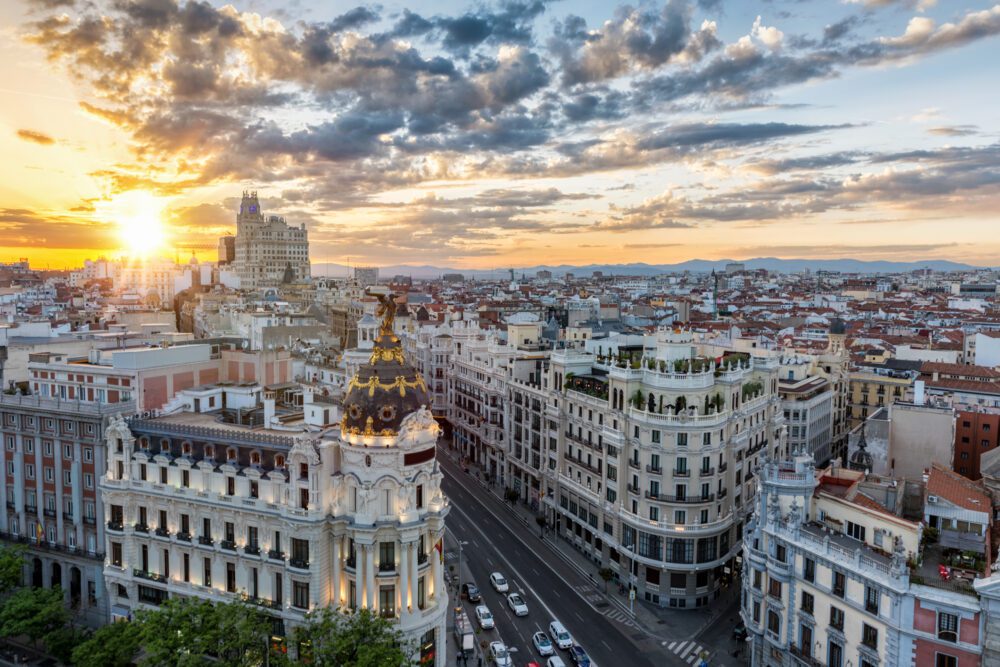
Introduction
Welcome to the vibrant capital city of Spain, Madrid, where history and modernity blend seamlessly to create an unforgettable urban experience. Nestled in the heart of the Iberian Peninsula, Madrid stands as a cultural and artistic powerhouse, boasting a rich tapestry of architectural wonders, world-class museums, and a lively culinary scene. From its bustling plazas and grand boulevards to its charming neighbourhoods and sprawling parks, Madrid offers a dynamic and diverse array of attractions that cater to every traveller’s taste and preference.
With a history dating back over a thousand years, Madrid has served as the epicentre of Spanish culture and politics, witnessing the rise and fall of empires, the reign of monarchs, and the birth of artistic movements. Today, the city’s historic landmarks, such as the Royal Palace and the Prado Museum, stand as a testament to its storied past, while its modern infrastructure and cosmopolitan atmosphere reflect its status as a global metropolis. Whether you’re strolling through the narrow streets of the old town, indulging in tapas at a local tavern, or admiring masterpieces by Goya and Velázquez, Madrid offers a wealth of experiences that will captivate and enchant visitors from around the world.
Table of Contents
Map of the Best Things to Do in Madrid
Royal Palace of Madrid
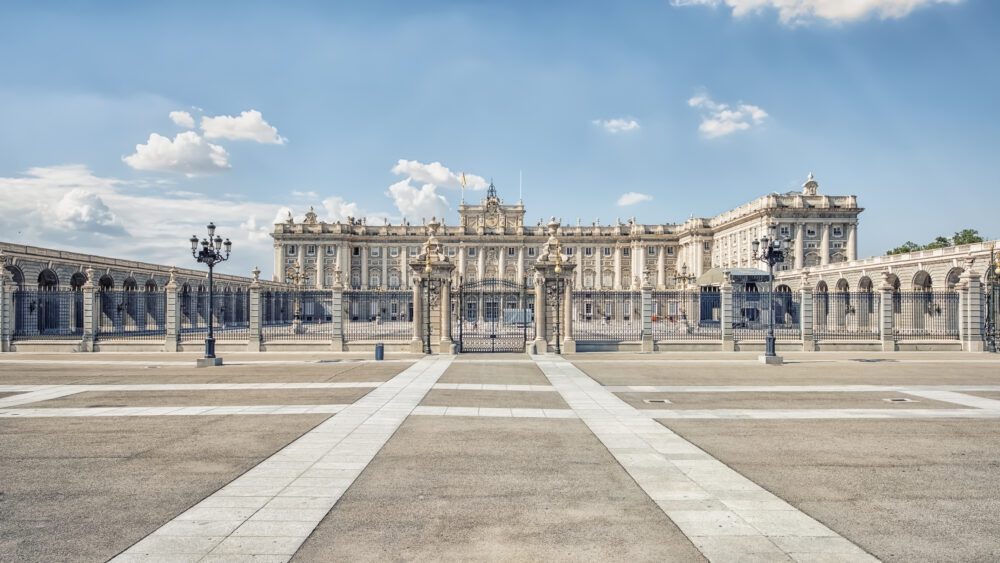
The Royal Palace of Madrid, an architectural marvel located in the heart of the Spanish capital, stands as a symbol of the grandeur and opulence of the Spanish monarchy. Built in the 18th century, the palace serves as the official residence of the Spanish royal family, although it is primarily used for state ceremonies and official events rather than as a royal residence. With over 3,000 rooms, the Royal Palace is one of the largest palaces in Europe, boasting lavish interiors adorned with priceless artworks, ornate furniture, and intricate tapestries. Visitors to the palace can explore its sumptuous staterooms, including the Throne Room, the Hall of Mirrors, and the Royal Chapel, which showcase the palace’s rich history and architectural splendour.
When planning your visit to the Royal Palace of Madrid, it’s advisable to book tickets online in advance to avoid long queues at the entrance. Consider joining a guided tour or using an audio guide to gain insights into the palace’s history, architecture, and royal residents. Be sure to allocate plenty of time to explore the palace’s extensive grounds and gardens, which offer panoramic views of the city skyline and surrounding landmarks. Don’t miss the opportunity to attend the Changing of the Guard ceremony, which takes place outside the palace gates on Wednesdays and Saturdays and is a colourful and ceremonial spectacle. Finally, after your visit, take time to stroll through the nearby Plaza de Oriente and enjoy the majestic beauty of this historic square.
Book Tickets: Royal Palace Tour with Optional Royal Collections
Plaza Mayor
Plaza Mayor, a grand and historic square nestled in the heart of Madrid’s bustling city centre, stands as a timeless symbol of the Spanish capital’s rich cultural heritage and architectural splendour. Originally constructed in the 17th century during the reign of King Philip III, the Plaza Mayor has served as a focal point for civic and social gatherings throughout Madrid’s history. Enclosed by elegant Baroque-style buildings adorned with ornate balconies and frescoes, the square exudes an air of grandeur and grandiosity. Visitors to Plaza Mayor can soak in the atmosphere of this iconic landmark while strolling along its cobblestone streets, admiring the intricate facades of the surrounding buildings, and marvelling at the impressive statue of King Philip III that takes centre stage in the square.
When exploring Plaza Mayor, be prepared for crowds, especially during peak tourist hours and weekends. Take time to explore the arcades and alleys that branch off from the main square, where you’ll find a variety of shops, cafes, and restaurants offering traditional Spanish cuisine and souvenirs. Don’t miss the opportunity to visit the Casa de la Panadería, an emblematic building located on the eastern side of the square, which houses exhibitions and cultural events throughout the year. Additionally, consider joining a guided walking tour to learn more about the history and significance of Plaza Mayor, or simply find a spot on one of the square’s benches to sit back, relax, and soak in the vibrant atmosphere of this iconic Madrid landmark.
Mercado de San Miguel
San Miguel Market, located in the heart of Madrid’s historic centre, is a gastronomic haven that offers visitors a vibrant culinary experience amidst a setting of architectural splendour. Dating back to the early 20th century, the market was originally built as a traditional food market to serve the local community. In recent years, it has undergone a transformation into a gourmet market, attracting food lovers from near and far with its enticing array of gourmet delicacies and artisanal products. The market’s iron-and-glass structure, reminiscent of Paris’s iconic Les Halles market, provides a picturesque backdrop for exploring the myriad food stalls and sampling a diverse range of Spanish cuisine, from freshly shucked oysters and Iberian ham to creative tapas and international fare.
When visiting San Miguel Market, arrive hungry and ready to indulge in a culinary adventure. Be prepared for crowds, especially during peak hours, and consider visiting during off-peak times for a more relaxed experience. Take time to wander through the market’s labyrinthine aisles, where you’ll find a tempting array of food stalls offering everything from traditional Spanish dishes to innovative culinary creations. Don’t miss the opportunity to pair your food with a glass of Spanish wine or vermouth from one of the market’s wine bars, or sample some local cheeses and charcuterie at one of the gourmet shops. Additionally, consider joining a guided tour to learn more about the market’s history and culinary offerings, or simply take a seat at one of the communal tables and soak in the lively atmosphere while savouring the flavours of Spain.
Puerta del Sol
Puerta del Sol, often referred to as the heart of Madrid, is a bustling square steeped in history and brimming with vibrant energy. Translating to “Gate of the Sun,” Puerta del Sol has served as a significant landmark in Madrid for centuries, with its origins dating back to the 15th century when it was one of the city’s gates. Over the years, it has evolved into a lively hub of activity, playing host to cultural events, political demonstrations, and festive celebrations. At the centre of the square stands the iconic clock tower, which serves as the official symbol of Madrid and marks the spot from which all distances in Spain are measured. Visitors to Puerta del Sol can take in the sights and sounds of this bustling square, browse the numerous shops and cafes that line its streets, and soak up the vibrant atmosphere that defines Madrid’s city centre.
When visiting Puerta del Sol, be prepared for crowds, especially during peak tourist hours and weekends. Take time to explore the surrounding streets and alleys, where you’ll find hidden gems such as traditional tapas bars, artisanal shops, and historic landmarks. Don’t miss the opportunity to sample some Spanish delicacies at one of the many restaurants and cafes in the area, or simply grab a seat on one of the benches and watch the world go by. Keep an eye out for street performers and artists who often entertain visitors with their talents, adding to the lively ambience of the square. Finally, consider visiting Puerta del Sol at night when it comes alive with colourful lights and a festive atmosphere, offering a unique perspective on this iconic Madrid landmark.
Gran Vía
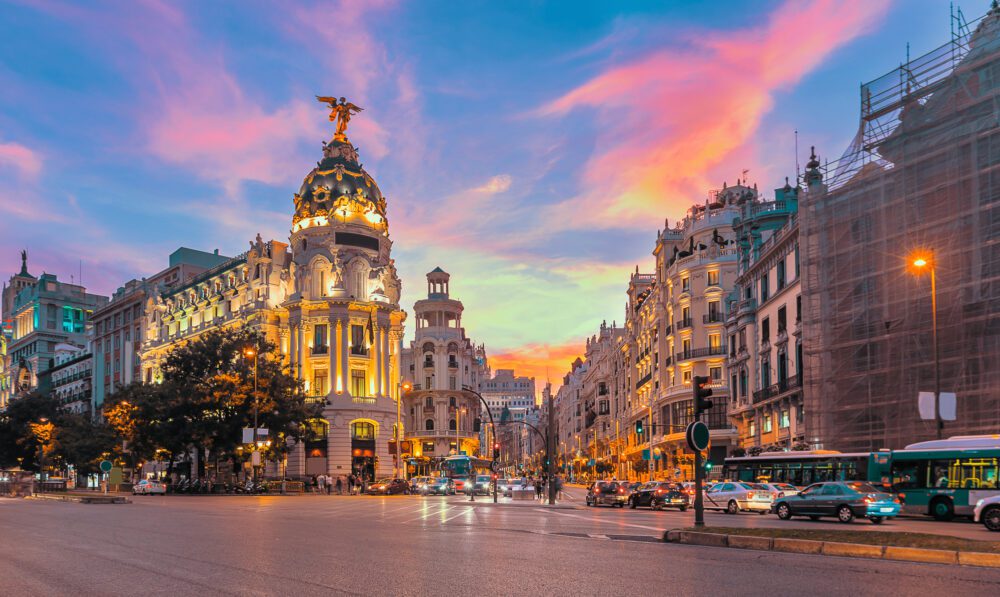
Gran Vía, often referred to as the “Broadway of Madrid,” is one of the city’s most iconic thoroughfares, renowned for its vibrant energy, dazzling architecture, and bustling atmosphere. Originally conceived in the early 20th century as part of an urban renewal project, Gran Vía quickly became a symbol of Madrid’s modernity and cosmopolitanism. Lined with majestic buildings, stylish boutiques, theatres, and cinemas, Gran Vía exudes a palpable sense of excitement and glamour. Visitors can stroll along the wide sidewalks, admiring the grandeur of landmark buildings such as the Edificio Metrópolis and the Telefonica Building, or indulge in a spot of shopping at one of the many fashion stores and department stores that line the street.
When exploring Gran Vía, be prepared for crowds, especially during peak hours and weekends when the street is bustling with activity. Consider taking a leisurely walk along the street in the evening when the buildings are illuminated, casting a magical glow over the thoroughfare. Don’t miss the chance to catch a show at one of Gran Vía’s historic theatres, such as the Teatro Coliseum or the Teatro Lope de Vega, which regularly host performances ranging from musicals and plays to concerts and dance shows. For a taste of local cuisine, be sure to stop by one of the many cafes, bars, or restaurants along Gran Vía and indulge in some traditional Spanish dishes or tapas.
Plaza de Cibeles
Plaza de Cibeles, an iconic square located in the heart of Madrid, is a stunning showcase of neoclassical architecture and a symbol of the city’s grandeur and cultural heritage. The centrepiece of the square is the magnificent Cibeles Fountain, designed by architect Ventura Rodríguez in the 18th century. The fountain features the Greek goddess Cybele, symbolizing fertility, riding in a chariot pulled by lions. Surrounding the square are several prominent buildings, including the Palacio de Cibeles, formerly the headquarters of the Spanish postal service and now a cultural centre, and the stunning Palacio de Buenavista, home to the Army General Headquarters. Plaza de Cibeles has long been a gathering place for locals and visitors alike, serving as a backdrop for celebrations, protests, and cultural events.
When visiting Plaza de Cibeles, be sure to take time to admire the intricate details of the Cibeles Fountain and the surrounding buildings, which are particularly striking when illuminated at night. Consider visiting the Palacio de Cibeles to explore its exhibitions and enjoy panoramic views of the city from its rooftop terrace. For a unique perspective of the square, consider joining a guided walking tour that provides insights into its history and significance. Additionally, be sure to capture photos of the iconic landmarks and sculptures that adorn the square, including the iconic Cibeles Fountain and the statues of Neptune and Cybele.
Thyssen-Bornemisza Museum
The Thyssen-Bornemisza Museum, located along Madrid’s prestigious Paseo del Prado, is a treasure trove of art spanning seven centuries and featuring works from some of the world’s most renowned artists. Originally founded from the private collection of German-Hungarian industrialist Baron Hans Heinrich Thyssen-Bornemisza, the museum has grown to become one of Spain’s premier cultural institutions since its inauguration in 1992. The museum’s impressive collection includes masterpieces from the Renaissance, Baroque, Rococo, and Romantic periods, as well as significant works from the 20th century. Visitors can marvel at iconic paintings by artists such as Caravaggio, Rembrandt, Van Gogh, Picasso, and Hopper, among others, providing a comprehensive overview of Western art history.
To make the most of your visit to the Thyssen-Bornemisza Museum, consider purchasing tickets online in advance to avoid long queues, particularly during peak tourist seasons. Be sure to allocate sufficient time to explore the museum’s extensive collection, which spans multiple floors and covers a wide range of artistic styles and movements. Consider joining a guided tour or using an audio guide to gain deeper insights into the artworks on display and their historical context. Additionally, don’t miss the museum’s temporary exhibitions, which offer unique perspectives on specific artists, themes, or periods in art history. Finally, after your visit, take time to relax in the museum’s picturesque courtyard, where you can enjoy a coffee or snack while reflecting on the masterpieces you’ve encountered.
Book Tickets: Thyssen Museum Guided Tour with Skip-the-Line Entry
Museo Nacional del Prado
The Prado Museum, nestled in the heart of Madrid, stands as one of the world’s premier art museums, boasting an unparalleled collection of European masterpieces spanning from the 12th to the early 20th century. Founded in 1819, the Prado Museum was initially established as a royal museum to showcase the Spanish royal family’s extensive art collection. Over the years, it has evolved into a cultural institution of international renown, housing iconic works by renowned artists such as Velázquez, Goya, El Greco, and Titian, among others. Visitors to the Prado can immerse themselves in a diverse array of artistic styles and genres, from the hauntingly realistic portraits of Velázquez to the emotive and politically charged works of Goya.
When planning your visit to the Prado Museum, consider purchasing tickets online in advance to skip the often lengthy queues at the entrance. Be sure to allocate ample time to explore the museum’s vast collection, as it spans multiple floors and covers a wide range of artistic periods and movements. Consider joining a guided tour or audio guide to gain insights into the significance and context of the artworks on display. Don’t miss the opportunity to visit the museum’s temporary exhibitions, which showcase works by contemporary artists and offer fresh perspectives on art and culture.
Book Tickets: Skip-the-Line Prado Museum Guided Tour
El Retiro Park
Retiro Park, one of Madrid’s most beloved green spaces, offers visitors a tranquil retreat from the hustle and bustle of city life. Originally a royal garden belonging to the Spanish monarchy, Retiro Park was opened to the public in the late 19th century and has since become a favourite destination for locals and tourists alike. Spanning over 125 hectares, the park features lush gardens, scenic pathways, and iconic landmarks such as the Crystal Palace, the Fountain of the Fallen Angel, and the picturesque Estanque del Retiro pond. Visitors can enjoy leisurely strolls under the shade of towering trees, rent a rowboat to paddle across the tranquil waters of the pond, or simply relax and soak up the sun on one of the park’s verdant lawns.
When exploring Retiro Park, be sure to wear comfortable walking shoes, as the park’s expansive grounds offer plenty of opportunities for exploration. Consider bringing along a picnic to enjoy in one of the park’s designated picnic areas or grab a snack from one of the vendors selling refreshments near the pond. Don’t miss the chance to visit the iconic Crystal Palace, a stunning glass-and-iron structure that houses temporary exhibitions and offers panoramic views of the surrounding gardens. For a unique experience, consider renting a rowboat to paddle around the Estanque del Retiro pond or rent a bicycle to explore the park’s many trails and pathways. Finally, be sure to visit the park’s numerous sculptures and monuments, which offer insights into Spain’s rich cultural heritage and history.
Reina Sofía Museum
The Reina Sofía Museum, located in the heart of Madrid’s cultural district, is a renowned institution dedicated to modern and contemporary art. Named after Queen Sofía of Spain, the museum opened its doors to the public in 1992, with the aim of showcasing Spain’s rich artistic heritage while also fostering dialogue and engagement with contemporary art practices from around the world. The museum’s collection features works by some of the most influential artists of the 20th and 21st centuries, including Pablo Picasso, Salvador Dalí, Joan Miró, and Eduardo Chillida. One of the museum’s most iconic pieces is Picasso’s monumental painting “Guernica,” which serves as a powerful symbol of anti-war sentiment and remains one of the most celebrated artworks of the modern era.
When visiting the Reina Sofía Museum, consider purchasing tickets online in advance to avoid long queues at the entrance, especially during peak hours. Be sure to allocate plenty of time to explore the museum’s extensive collection, which spans multiple floors and includes paintings, sculptures, photographs, and multimedia installations. Consider joining a guided tour or using an audio guide to gain deeper insights into the artworks on display and the historical context in which they were created. Don’t miss the opportunity to attend one of the museum’s temporary exhibitions, which showcase works by contemporary artists and offer fresh perspectives on art and society. Finally, after your visit, take time to relax and unwind in the museum’s outdoor courtyard, where you can enjoy a coffee or snack while reflecting on the artworks you’ve encountered.
Book Tickets: Reina Sofía Guided Tour with Skip-the-Line Tickets
El Rastro Market
El Rastro Market, located in the heart of Madrid’s historic La Latina neighbourhood, is one of the city’s oldest and most iconic open-air markets. Dating back to the Middle Ages, El Rastro has a rich history as a vibrant marketplace where locals and visitors alike come to browse and shop for a wide variety of goods. The market takes place every Sunday and public holiday, filling the narrow streets and plazas of La Latina with a lively atmosphere and a kaleidoscope of colours and sounds. Visitors to El Rastro can expect to find a diverse array of merchandise, including clothing, accessories, antiques, furniture, artwork, and much more, making it the perfect destination for bargain hunters and treasure seekers.
When visiting El Rastro Market, it’s best to arrive early to beat the crowds and have the widest selection of goods to choose from. Be prepared to navigate through narrow streets and crowded alleyways, and wear comfortable shoes for walking. Bargaining is common at El Rastro, so don’t hesitate to negotiate prices with vendors to get the best deals. While exploring the market, be sure to take a break at one of the many cafes and bars lining the streets, where you can enjoy a refreshing drink or sample some traditional Spanish tapas. Finally, don’t forget to keep an eye on your belongings, as the market can get crowded and pickpockets may take advantage of the bustling atmosphere.
Temple of Debod
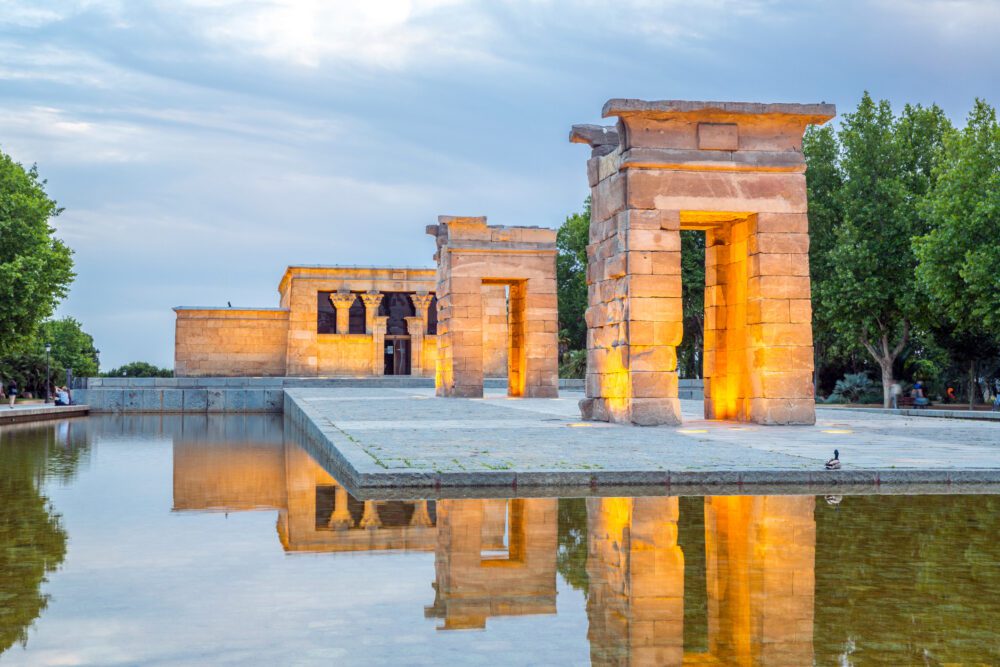
The Temple of Debod, an ancient Egyptian temple nestled in the heart of Madrid’s Parque del Oeste, stands as a captivating testament to the city’s rich cultural diversity and history. Originally built in the 2nd century BC in the region of Nubia (present-day Sudan), the temple was dedicated to the gods Amun and Isis. In the 20th century, as a result of the construction of the Aswan High Dam, the temple faced the threat of flooding, prompting the Egyptian government to gift it to Spain in gratitude for the country’s assistance in preserving other ancient sites. Transported stone by stone and meticulously reconstructed in Madrid, the Temple of Debod now serves as a serene oasis amidst the bustling city streets, offering visitors a glimpse into ancient Egyptian civilization.
When visiting the Temple of Debod, consider timing your visit to coincide with sunset, when the temple and surrounding park are bathed in golden light, creating a magical atmosphere. Admission to the temple is free, and visitors are welcome to explore both the exterior and interior, where they can admire well-preserved hieroglyphs and architectural details. Be sure to take advantage of the elevated vantage points around the park, which offer panoramic views of the city skyline and iconic landmarks such as the Royal Palace and the Almudena Cathedral. Additionally, consider bringing a picnic to enjoy in the park’s tranquil surroundings or joining a guided tour to learn more about the temple’s fascinating history and significance.
Santiago Bernabéu Stadium
Santiago Bernabéu Stadium, the iconic home of Real Madrid Football Club, stands as a shrine to the beautiful game and a testament to the passion of football fans worldwide. Named after the legendary Real Madrid president Santiago Bernabéu Yeste, the stadium has been witness to countless historic moments in football history since its inauguration in 1947. With a seating capacity of over 80,000 spectators, Santiago Bernabéu is one of the largest and most iconic football stadiums in Europe. Visitors to the stadium can embark on a guided tour to explore its hallowed grounds, including the player’s tunnel, the trophy room showcasing Real Madrid’s extensive collection of silverware, and the VIP boxes offering panoramic views of the pitch.
When planning a visit to Santiago Bernabéu Stadium, be sure to book tickets for the guided tour in advance, as they tend to sell out quickly, especially during peak tourist seasons. Consider opting for a tour that includes access to areas typically off-limits to the public, such as the team dressing rooms and the press room, for a more immersive experience. Don’t forget to bring a camera to capture memories of your visit, and consider purchasing some official Real Madrid merchandise from the stadium’s souvenir shop as a memento of your time at one of the world’s most iconic football stadiums.
Book Tickets: Guided Tour of Bernabéu Stadium
Casa de Campo
Casa de Campo, sprawling across over 1,700 hectares, stands as Madrid’s largest public park and a cherished recreational retreat for locals and visitors alike. Originally a royal hunting estate dating back to the 16th century, Casa de Campo was later opened to the public in the mid-20th century, becoming a beloved green oasis in the heart of the city. Today, the park offers a wide range of activities and attractions, from scenic walking and cycling trails to boating on the lake, picnicking in lush meadows, and exploring the diverse flora and fauna of its natural landscapes. For those seeking thrills, the park is also home to attractions such as an amusement park, a zoo, and a cable car offering panoramic views of Madrid’s skyline.
When exploring Casa de Campo, wear comfortable shoes and dress appropriately for outdoor activities, especially during the hot summer months when shade can be limited. Consider renting a bike or bringing along a picnic to make the most of your time in the park. Don’t miss the opportunity to visit the Teleférico de Madrid, a cable car that provides stunning aerial views of Casa de Campo and the city beyond. For a more leisurely experience, take a boat ride on the park’s lake or enjoy a stroll along the many scenic pathways that wind through its wooded areas and open spaces. Finally, be sure to check out the park’s cultural attractions, including the Madrid Zoo Aquarium and the Parque de Atracciones amusement park, which offer fun-filled experiences for visitors of all ages.
Day Trip to Toledo
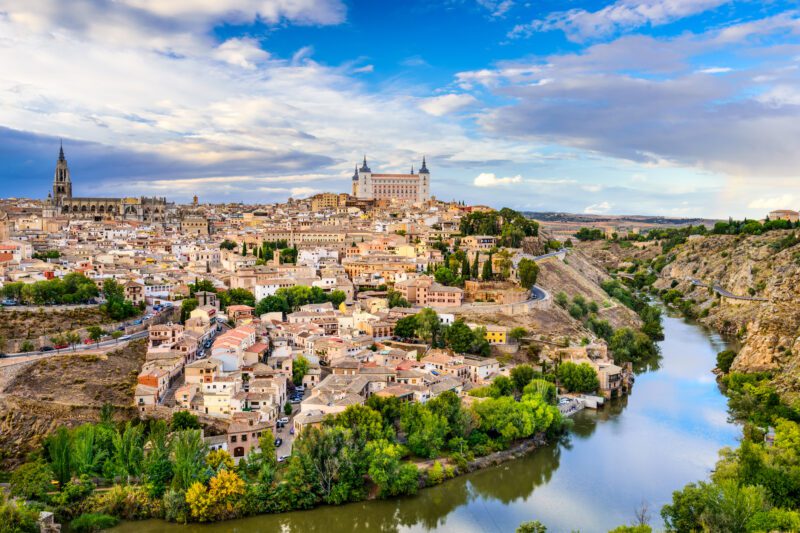
A day trip to Toledo, a UNESCO World Heritage Site and a treasure trove of history and culture, promises an unforgettable journey back in time to Spain’s medieval past. Known as the “City of Three Cultures” for its rich blend of Christian, Muslim, and Jewish heritage, Toledo boasts a wealth of architectural marvels, ancient monuments, and winding cobblestone streets. One of the city’s most iconic landmarks is the imposing Alcázar of Toledo, a fortress perched atop a hill that offers panoramic views of the city and surrounding countryside. Visitors can explore the labyrinthine streets of the old town, visit historical sites such as the Toledo Cathedral and the Synagogue of Santa María la Blanca, and marvel at the intricate craftsmanship of the city’s famous Damascene jewellery.
Consider joining a guided tour that also includes visits to the nearby cities of Ávila and Segovia for a comprehensive exploration of the region’s cultural heritage. Guided tours typically provide transportation between the cities, allowing visitors to maximize their time and experience the highlights of each destination with the expertise of a knowledgeable guide. Additionally, be sure to wear comfortable walking shoes and dress appropriately for exploring historic sites, as Toledo’s cobblestone streets and steep hills can be challenging to navigate. Finally, don’t forget to sample some of Toledo’s culinary delights, such as its famous marzipan sweets and traditional Castilian cuisine, at one of the city’s charming cafes or restaurants.
Conclusion
Madrid stands as a vibrant and dynamic city with an abundance of cultural riches and experiences to offer visitors. From its world-class museums and historical landmarks to its lively plazas, bustling markets, and picturesque parks, Madrid captivates travellers with its unique blend of history, art, and gastronomy. Whether you’re wandering through the winding streets of the old town, savouring tapas in a traditional tavern, or admiring masterpieces in renowned art galleries, every corner of Madrid holds a new adventure waiting to be discovered.
Ultimately, the best things to do in Madrid are as diverse and eclectic as the city itself, catering to a wide range of interests and preferences. Whether you’re a history buff, an art enthusiast, a foodie, or simply seeking to immerse yourself in the vibrant energy of a bustling metropolis, Madrid offers a plethora of experiences that promise to leave a lasting impression. With its rich cultural heritage, lively atmosphere, and warm hospitality, Madrid invites visitors to explore, discover, and embrace the essence of Spanish culture in one of Europe’s most enchanting capitals.
